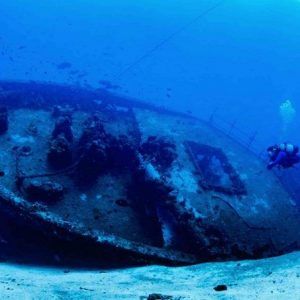Interest in the wreck of a ship believed to be from one of China's 15th Century treasure fleets started a chain of events that has led to what will be a first for Africa when it opens in 2022 - an underwater museum. It may also translate into a lot more local and international tourists - especially from China.
By Gitonga Njeru, bird
Jostel Mugwithania, aged 61, is a keen traveller. A former pilot, he has travelled to over 102 countries and seen the Pyramids of Egypt, the Grand Canyon, Venice Beach in California, the House of Slaves in Dakar, the Great Wall of China, and the TajMahal in India. He has never been to an underwater museum. And he cannot wait to go.
He will get his opportunity this year (2022), if things go according to plan. Not on another continent, but right "at home" in east Africa.
Mugwithania, a practising large-scale Kenyan farmer and former pilot, is sure that the underwater museum due to open in a few months on the east African coast will offer an experience of a lifetime, even for someone as well-travelled as he is.
“I have travelled to some of the best tourist sites in the world, but never have I entered an underwater museum. Technology is so diverse that we can now construct such structures. Wow. It is something that is on my to-do list."
The site where Africa’s first underwater museum is to be implemented has undergone a successful environmental impact assessment and is already partly complete, according to officials. It was originally due to open in 2022 but construction was delayed by COVID-19. However, officials remain optimistic that the site will be completed during the year.
“I can't wait to visit the site once it is operational, I will take my entire family along. I have travelled to over 102 countries around the world spanning over six continents. I am still young and I believe I will do more travelling. It is also good to promote local tourism,” Mugwithania told bird.
An associated research site that will primarily study marine life as well as ancient shipwrecks and is to be located in Kilifi, one hour’s drive north from Kenya’s tourist city of Mombasa.
Work to develop the museum also involves excavation and preservation at underwater sites in the western Indian ocean. The work will highlight discoveries by a joint team of 22 Chinese and Kenyan archaeologists who uncovered ancient shipwrecks in the area dating back to the Ming Dynasty in China. Some of the shipwrecks are more than 600 years old and are expected to become a major tourist attraction. Submerged artwork that explains and highlights the area's maritime history are part of the museum.
“Viewing the underwater resources that we have through this technology will be exciting. Such underwater resources are much unexploited. It is something that will bring a lot of tourism. Promoting local tourism is very vital. We should not only depend on international arrivals but on our own local tourists,” Mugwithania added.
Once complete, the museum will span a 137-kilometre-long section of coastline, from the tourist town of Lamu in the north to Malindi further south. One wreck in the area is believed to have belonged to a mighty "treasure ship" armada commanded by the Ming Dynasty admiral, Zheng He. He is believed to have reached Malindi around 1418.
Marine archaeological evidence of the wreck is backed by recent DNA testing. It is believed that a handful of survivors from the wreck swam ashore.
Legend has it that the shipwrecked Chinese killed a python after it attacked a village and as a result were allowed to stay and marry local women, creating a community of African-Chinese whose descendants still live in the area.
According to Cesar Bita, a lead archaeologist on the project, the museum will also preserve important Portuguese and Arabic shipwrecks, one of which, a Portuguese wreck, will be a central point of the museum. Bita said the underwater displays will include iron ship-making tools and concrete artefacts.
“The museum, once fully operational, will also showcase and demonstrate the interaction between art and environmental science in a unique way, Bita explained.
“We have already displayed items left from the Chinese shipwrecks, such as lead metals, copper ingots and several different types of Chinese ceramics. The facility will also contain a few permanent life-sized structures, making it one of the world’s largest once complete and fully operational”, said Bita.
"The reason the Chinese government has already started to fund the project is that the location that it is set to be built contains ancient Chinese shipwrecks and other Chinese treasures."
“Venturing into underwater museums is very expensive and the idea is relatively new worldwide. Constructing the facility takes a lot... But this is something we are determined to complete. We have to move with changing times”, said Bita during an interview with bird.
Currently, according to The United Nations Educational, Scientific and Cultural Organization (UNESCO), there are only 11 underwater museums in the world. Most are located in North America and Asia. There is only one such facility in Europe.
The east Africa coast already sports an underwater hotel, located off the coast of Tanzania, while a second is planned for Mombasa.
According to Bita, another African underwater museum project is underway in Alexandria, Egypt.
Kilifi County governor, Anderson Kingi said that tourists are already beginning to visit the east African museum site, which is already partially operational.
"The site has some of the rarest marine ecosystems in the world and also attracts... tourists from across the world to witness many of the events that took place in the ancient world, such as Chinese shipwrecks and also slave trade to the Middle East.
"Chinese make up about 20 per cent of our annual tourism numbers. So this is good news,” said Kingi, pointing out that the coast attracts some 70 per cent of visitors to Kenya.
Kingi further confirmed that the Chinese government is currently training and equipping Kenyan archaeologists with underwater archaeology equipment in preparations for underwater undertakings related to the site.
“This undertaking is relatively new and expensive but it is worth the time and effort. We want to move forward as a country through innovation”, Kingi said.
The museum will compete with other museums around the world as its facilities will be world-class. It will be comparable to Europe’s largest underwater museum opened in Turkey in 2019, according to officials. The facility located in Antalya Turkey showcases an impressive 110 sculptures, while the world’s largest underwater museum - in Cancun, Mexico - is currently able to showcase 500 life-sized sculptures.
It is expected that the facility will be the biggest tourist attraction in the coastal region of Kenya and the Kenyan government is hoping to use the museum to double the number of toursts to the area. They hope Chinese tourists will make up 20 per cent of the arrivals.
Certainly, one long-time Chinese resident in Kenya is optimistic that the site will be an attractive destination.
"I will be happy to visit the museum and see many new wonders once it is complete," said Jing Li, 47, who works at the Confucius Institute at the University of Nairobi.
“I have seen the country grow from nothing to something. It has really grown. The coast has many tourist sites and I encourage people to visit this beautiful country. There is so much on offer. The times when Africa was thought to be a dark continent are long gone. It has a bright future”, she said.
According to Audrey Azoulay, the head of UNESCO, many countries are realizing the importance of their underwater resources and constructing underwater facilities to help conserve them. According to Azoulay underwater facilities have become increasingly important for development, including education and economic growth.
“As a matter of fact, many countries are now venturing into the construction of high standard, up-to-date underwater facilities as a way of preserving their resources for their own educational and economic gains. This move has increased global tourism and many people want to know more about world history. More such facilities are being built the world over”, said Azoulay who became the Director-General in 2017.
According to the UNESCO head, South Africa, Angola, Senegal, Ghana and Morocco are in the planning stages of launching their own underwater museums. The innovative technology is very new, with Israel launching its own underwater Museum in April 2006.
“Doing business underwater is almost similar to doing it in space. This technology is relatively unexploited and it’s only in the recent past that a lot of discoveries are being made”, said Azoulay.
According to Azoulay, other countries that are considering building their own underwater sites include Bolivia, Bangladesh, and India. Japan is also considering building a major underwater museum in the near future, in addition to the Ashizuri underwater observation tower, which extends seven meters below the ocean surface.
According to Najib Balala, Kenya’s Cabinet Secretary in the Tourism Ministry, tourism revenues are expected to grow to about 2.5 billion US dollars by the end of this year, a growth of some 23 per cent from last year. He has welcomed the ongoing construction of the underwater site.
“Obviously, new innovative ventures will increase the way business is done. The underwater facility, once fully operational, will go a long way. It’s time that many countries stop considering us and classifying us as a third world country. We have a lot of potential. The Kenyan coast already has some of the best hotels in the world, we will have more to offer”, said Balala.
According to University of Nairobi Economics Professor Germano Mwabu, the facility will be able to accommodate a substantial number of visitors.
“The facility will have a lot of potential and why do I say so? Underwater Museums can accommodate an average of between 90,000 to about 200,000 visitors per year.
"They attract people because psychologically, many are eager to know what really happens underwater. It is something many people are willing to pump their money so as to realize their adventures," says Mwabu who is also an Africa consultant to the World Bank.
“I'm very sure that this facility... could attract a large chunk of visitors from not just this continent, but from five other continents," Mwabu added.
According to Mwabu, Kenya ranks fourth in Africa as a tourist destination, trailing Egypt, Algeria and South Africa. But he says that the strategies that Kenya is using to gain numbers could make it the leading destination within two years.
“We are getting a lot of competition from Tanzania which currently has an underwater hotel... the Manta Resort, you can view fish and mother nature right in the comfort of your hotel room that is constructed underwater," he said.
Mwabu believes the underwater museum will set the pace for similar projects in the region. With any luck, the well-travelled Jostel Mugwithania will soon be able to tick it off his long list of world-class destinations.
bird story agency
You will also love: The Ngaren Museum of Humankind: A Futuristic Marvel to Pay Homage to The Past





